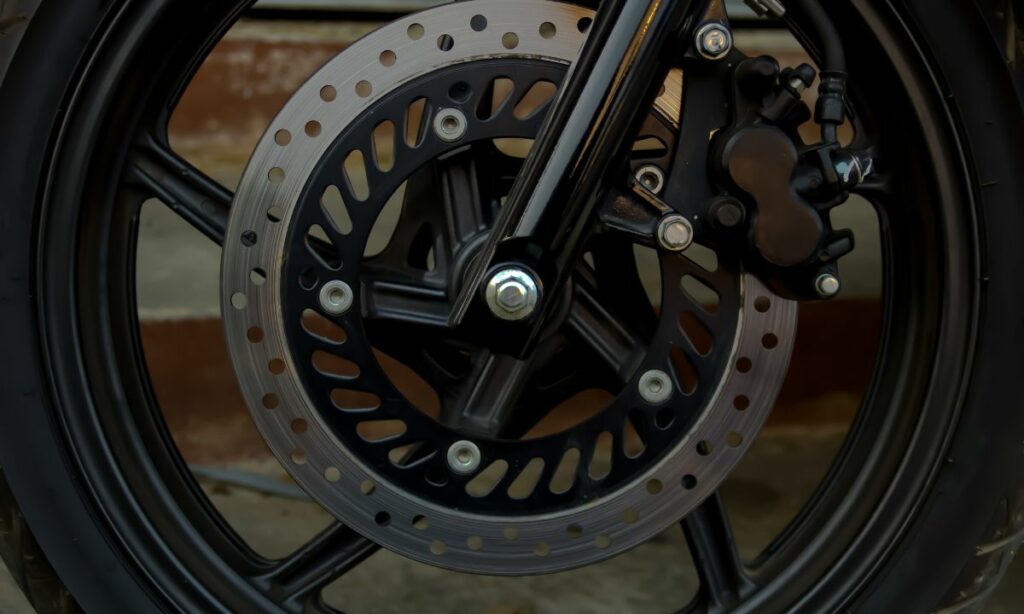Disc rotors are something no one bothers about until it turns blue or thins out too much. That’s when you worry if it’s time to replace it.
So when should you replace motorcycle disc rotors?
Motorcycle disc brake rotors need to be replaced when their thickness falls below the minimum required thickness. There is no timeline or a distance traveled threshold for replacing disc rotors.
Only the wear and tear and the low rotor thickness is the criteria for replacement.
Let’s dig deeper into the criteria for replacement, how to measure thickness, causes and preventive measures for disc rotor wear.
No specific timeline for replacement
Brake discs on motorcycles do not need replacements like the consumables (oils) and other parts do.

The engine oil, brake fluid, fork oil, etc. have a timeline for replacement. The timeline might vary from 5000 miles to 20,000 miles depending on the type of fluid we are talking about.
The same is the case for many other motorcycle components like air filter, brake pads, oil filter, etc. Their replacement is dependent on the miles traveled.
But, disc rotors are not replaced depending on the miles traveled. Nor are they taken out based on a timeline.
When to replace the disc brake rotor?
The disc brake rotor on a motorcycle must be replaced when the rotor plate thickness falls below the minimum required thickness.

Unlike other motorcycle parts which are replaced based on timeline or miles traveled, the disc rotor does not follow any such replacement guidelines.
Rather, they are replaced when they wear out and the rotor plate thickness is too low.
This wear out can happen in 10,000 miles or 100,000 miles. Can happen within a year, or 5 years. It all depends on the brake disc condition.

The only criterion for replacement is – if the rotor thickness is less than the minimum required thickness.
That’s it. That’s the one and only measure to check whether your disc rotor needs to be replaced or not.
Minimum required thickness and current actual thickness
Now let’s discuss how to get the minimum required thickness as well as how to measure the current rotor plate thickness.
How to find the rotor’s minimum thickness
The minimum required thickness is mentioned on the rotor plate itself.
You can check the disc plate and can see a minimum required thickness as something like – ‘4mm’ or ‘3.5mm’ or whatever the required number is.

In case the rotor plate is too dirty and you can’t clearly see the minimum thickness label, there is another way.
Check the bike owner’s manual.
The motorcycle owner’s manual also contains the minimum required thickness for the disc rotor.
This is not cent percent working though. Some owner manuals don’t contain this information.
Note: Checking the owner’s manual works if and only if the disc rotor is factory-installed. If the disc is replaced from the original one, checking the owner’s manual is not useful.
How to check the rotor’s actual thickness
Measuring the actual rotor plate thickness is quite tricky. You can’t use a simple ruler. It’s not going to give an accurate reading.
Then what’s the solution?
You need a tool that can measure something really thin. At a scale of millimeters (mm).
My preferred tool to measure the disc rotor thickness is a digital caliper.

Alternatively, you can also use a vernier caliper or a micrometer to measure the rotor thickness.

The key here is the tool must be able to measure accurately in terms of mm. As long as it fits this bill, you ate free to use it on the rotor.
Causes for disc rotor wear out
We now know the disc rotor has to be replaced if it wears out to the point of its thickness falling below the minimum required thickness.

Then what causes this wear?
Here are the main reasons that cause rotor plate wear:
- Worn-out brake pads: If the brake pads are worn-out they will wear out the disc rotor fast. If the brake pad friction material is less than 1/16 inch thick, it will start to damage the disc rotor.
- Unnecessary braking: Lots of unnecessary braking and hard braking is going to take its toll on the disc rotor over time. The rotor plate will start wearing down.
- Poor riding conditions: If you travel on busy roads daily, where traffic is high, you will be applying brakes much more frequently. As a result, the disc rotor life can be much shorter.
Preventive measures
How can you prevent rotor plate wear? And how can you prolong the disc rotor lifespan?

Here are a few preventive measures to increase the disc rotor lifespan:
- Use high-quality brake pads.
- Replace brake pads regularly. On average, brake pads need to be replaced every 20,000 miles (32,000 kilometers).
- Ensure the friction material brake pad is thick. If the thickness is less than 1/16th of an inch, i.e., less than 0.07 inch, you must replace the brake pads.
- Maintain good braking habits. Do not speed up fast and then brake hard to even cover a short distance.
- If possible, avoid poor riding conditions like bumpy roads, high traffic, and busy streets. Riding on good and less busy roads helps in maintaining not just the rotor but the entire bike in good condition.
FAQs
Motorcycle rotors have varying lifespans. They can last 10,000 miles or 100,000 miles. The only rule to replace is when the rotor thickness falls below the minimum required thickness.
Yes. Rotors get thinner over time. With more miles traveled, the rotor starts to wear down. While the wear is nowhere as high as brake pads, disc rotors do experience wear and thin slowly over time.
Disc rotors have nothing to do with acceleration. Their function is to brake effectively and stop the wheel from moving. They do NOT affect motorcycle acceleration.
Before you go…
Here are a few more related posts that might interest you further:
